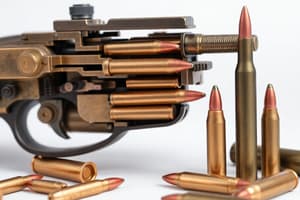Podcast
Questions and Answers
What type of cartridge was developed by Monsieur Le Facheux around 1896?
What type of cartridge was developed by Monsieur Le Facheux around 1896?
- Pin-fire cartridge (correct)
- Rimfire cartridge
- Shotgun cartridge
- Center-fire cartridge
What is a characteristic feature of rimfire cartridges?
What is a characteristic feature of rimfire cartridges?
- The ignition mechanism is located at the hollow rim of the case (correct)
- The diameter of the rim is significantly smaller than the body
- They are designed for use in machine guns
- The primer is located in the center of the cartridge
Which caliber is equivalent to approximately 9 mm?
Which caliber is equivalent to approximately 9 mm?
- .25 caliber
- .380 caliber (correct)
- .30 caliber
- .45 caliber
What describes a 'rimmed type' cartridge?
What describes a 'rimmed type' cartridge?
Which measurement is commonly used to express the gauge of a shotgun?
Which measurement is commonly used to express the gauge of a shotgun?
What is a characteristic of the belted type cartridge?
What is a characteristic of the belted type cartridge?
How do you convert caliber to millimeters?
How do you convert caliber to millimeters?
What is a defining feature of a semi-rimmed cartridge?
What is a defining feature of a semi-rimmed cartridge?
What is included in a complete unfired cartridge?
What is included in a complete unfired cartridge?
Which type of ammunition is specifically designed for military training without any explosive elements?
Which type of ammunition is specifically designed for military training without any explosive elements?
What term describes ammunition that pierces targets using a single bullet?
What term describes ammunition that pierces targets using a single bullet?
What distinguishes riot control ammunition from standard ammunition?
What distinguishes riot control ammunition from standard ammunition?
Which type of ammunition is used to produce a gunshot sound without actual projectiles?
Which type of ammunition is used to produce a gunshot sound without actual projectiles?
How did the term 'cartridge' originate?
How did the term 'cartridge' originate?
What is the primary function of high explosives in ammunition?
What is the primary function of high explosives in ammunition?
Which type of ammunition is primarily made for instructional purposes?
Which type of ammunition is primarily made for instructional purposes?
Flashcards are hidden until you start studying
Study Notes
Definition of Ammunition
- Ammunition encompasses loaded shells for various firearms including rifles, shotguns, and pistols, utilizing gunpowder or other explosives to propel projectiles.
- It includes air rifle ammunition, defined as complete unfired units comprising a bullet, gunpowder, cartridge case, and primer.
Technical Definition and Types
- A cartridge is a complete unfired unit including bullet (ball), primer, cartridge case, and gunpowder.
- Dummy Ammunition: Replica cartridges made for training and inspection purposes.
- Drill Ammo: Inert cartridges used for firearms training without explosive propellant.
- Blank Ammunition: Cartridges without bullets, producing sound and recoil, often used in training and theatrical performances.
- Live Ammunition: Real cartridges that are fully functional and unfired.
Classification by Effects
- Penetrators: Utilize a single bullet to pierce targets.
- High Explosives: Detonate before reaching targets, scattering fragments or creating jets of molten metal.
- Carrier Projectiles: Designed to disperse submunitions or materials upon nearing the target.
Riot Control Ammunition
- Employed by law enforcement to manage riots while minimizing serious injuries.
- Includes hard rubber bullets and soft rubber rings containing tear gas, designed to inflict less harm than conventional bullets.
Etymology of "Cartridge"
- The term originates from the Latin "charta" meaning paper, evolving through the French "cartouche", indicating historical use of paper in early cartridges.
Classification of Cartridges by Primer Location
- Pin-Fire: Obsolete self-exploding cartridges from around 1896 with concealed ignition caps.
- Rim Fire: Simple modern cartridges where priming mixture is located in the rim, ignited by striking the rim.
- Developed in 1845 by Flobert, marking the first rim cartridge.
Classification by Rim Diameter
- Rimmed Type: Has a diameter exceeding the cylindrical portion, commonly used in revolvers.
- Semi-Rimmed Type: Slightly wider rim than the body diameter.
- Rimless Cartridge: Diameters of the base and body are equal.
- Rebated Type: Smaller rim than the body.
- Belted Type: Cartridges attached in series for automatic firing.
Caliber and Corresponding Measurements
- .22 caliber approximately equals 5.59 mm; used in revolvers, pistols, and rifles.
- .25 caliber approximately equals 6.35 mm; applicable for pistols and rifles.
- .30 caliber, also at 7.63 mm, used for Mauser and Luger rifles.
- Various calibers range from .32 (7.65 mm) to .60, with a note on conversions (Caliber to millimeter: multiply by 25.4).
Shotgun Cartridges
- Consist of pellets, primer, case, wads, and gunpowder; essential for shotgun operation.
Gauge of Shotgun
- Gauges range from 10 (0.775 inch) to .410 (0.410 inch), with specific measurements noted.
Types of Shots
- Soft or Drop Shots: Made primarily from lead with added arsenic for shape retention.
Studying That Suits You
Use AI to generate personalized quizzes and flashcards to suit your learning preferences.



